|
Birds are flying vertebrates. They're built to fly with feathers and a strong but lightweight skeleton. All birds have beaks, whose shapes are specialized to the food they eat. For example, predatory birds (raptors) like hawks have hooked beaks to kill and dismember prey. Hummingbirds and other nectar feeders have bills designed to fit into flowers. Although bird songs can sound melodic and simple, they are very specific calls used to attract a mate or warn other birds. Arizona is a bird-watcher’s paradise. Saguaro National Park contains many species seen in few other places in the United States, such as vermilion flycatchers and whiskered screech owls. The diversity of habitats in the park ranges from lowland desert up to pine forests. These diverse ecosystems support a surprising array of bird life. Common desert birds include greater roadrunners, Gila woodpeckers, and Gambel’s quail. Northern goshawks, yellow-eyed juncos, and Mexican jays can be found in the park's higher elevations.
Common Birds in the Park
NPS Photo Roadrunner (Geococcyx californicus)This large member of the cuckoo family is probably the most famous bird of the Southwest. It is also an effective predator. Though it rarely flies, the roadrunner can reach speeds of 15 mph, which allow it to catch fast moving prey like lizards and rodents. When moving at high speeds, the roadrunner uses its tail as a rudder.The female lays eggs at intervals so that if there is a shortage of food, the younger birds are fed to the older hatchlings. 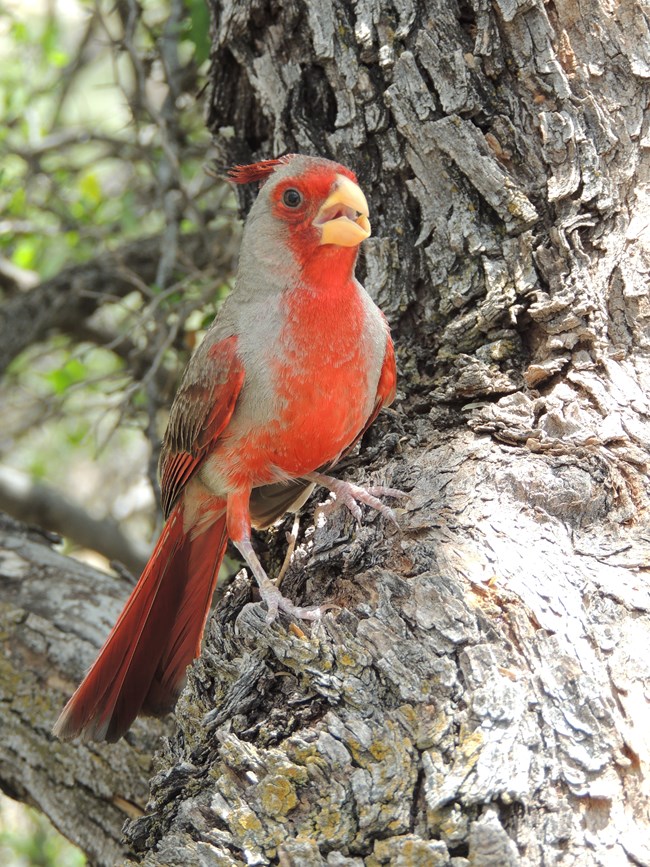
NPS Photo Pyrrhuloxia (Cardinalis sinuatus)The Northern cardinal and the pyrrhuloxia are very closely related. They have extremely similar songs and habits. Because they are similar in color, the male Pyrrhuloxia is often mistaken for a female cardinal. One easy way to tell them apart is the yellowish parrot-like bill of the pyrrhuloxia, versus the cardinal's red bill. 
NPS Photo Phainopepla (Phainopepla nitens)The phainopepla belongs to a small group of birds known as the silky flycatchers, but they are not related to true flycatchers. Their diet is primarily desert mistletoe. It disperses mistletoe seeds to host plants as the seeds pass through the birds’ digestive system. 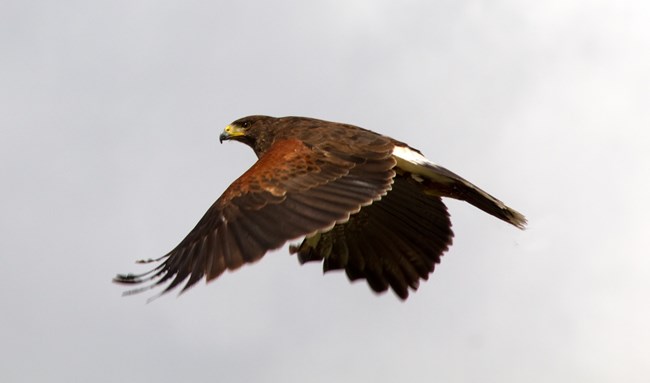
NPS Photo Harris’s Hawk (Parabuteo unicinctus)This common Sonoran Desert hawk is often seen in saguaro forests. Unlike most other hawks, the Harris’s hawk lives and hunts in social groups. Most groups consist of a breeding pair and several non-breeding adult birds that help in feeding the young, defending the nest, and hunting. They hunt in groups to increase hunting success, sometimes surrounding prey to flush it out of deep brush. 
NPS Photo Gila Woodpecker (Melanerpes uropygialis)This common Sonoran Desert woodpecker makes nest cavities in the sides of saguaros inbetween the skin and the inner ribs (the outer cortex) of the cactus. With the saguaro tissue serving as insulation, these cavities provide safety from predators and refuge from extreme temperatures. Abandoned woodpecker holes make great nests for elf owls, kestrels, and purple martins. 
NPS Photo Gambel's Quail (Callipepla gambelii)The Gambel’s quail is easy recognized by the black, comma-shaped top-knot protruding from its forehead. This bird avoids extreme summer temperatures by being most active during the early mornings and late afternoons. It spends the hottest part of the day in the shade. If water is available, the Gambel’s quail will drink daily; otherwise, it gets enough water to survive from eating insects and cactus fruit. 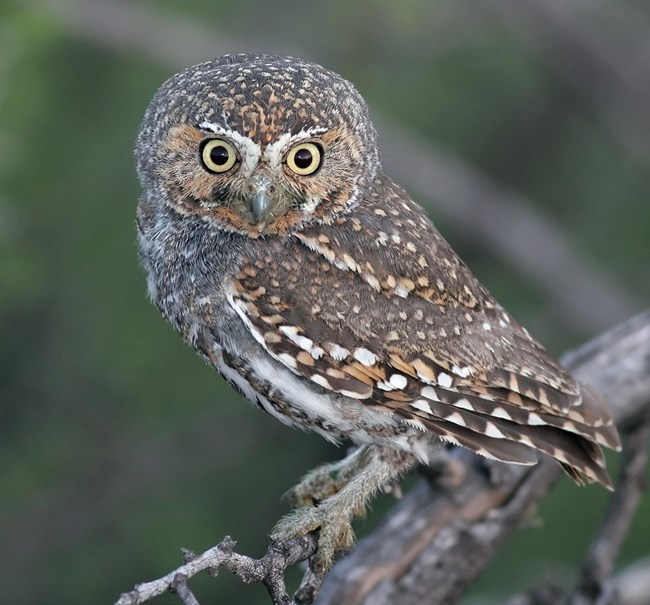
NPS Photo Elf Owl (Micrathene whitneyi)This tiny, nocturnal hunter is also the world’s smallest owl. Because of their size, elf owls feed chiefly on insects - usually beetles and moths. Elf owls nest in former woodpecker holes or cavities in trees and saguaros. Elf owls migrate to southern Mexico before the end of October and return to the Sonoran desert by March to breed. 
NPS Photo Curve-billed Thrasher (Toxostoma curvirostre)The curve-billed thrasher is a large, grayish-brown bird with yellow eyes and a noticeably curved bill. A ground forager, the curve-billed thrasher uses its bill to flick aside and dig in the soil for insects and seeds. It builds a nest of twigs in cholla cactus, yucca, or mesquite and has been known to destroy cactus wren nests when nesting sites are in demand. 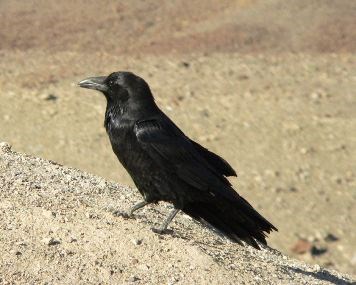
NPS Photo Common Raven (Corvus corax)The common raven is the largest member of the corvid family (jays, magpies, crows, and ravens). Although the common raven is extremely difficult to tell apart from the Chihuahuan raven by sight, the Chihuahuan raven is often found in groups, while the common raven is often seen alone or in pairs. Extremely adaptable birds, they are found in diverse habitats from forests to cities to Arctic ice flows. 
NPS Photo Cactus Wren (Campylorhynchus brunneicapillus)Thanks to its curious nature and rough, abrasive calls, the cactus wren is one of the best known birds of the Sonoran Desert. It’s the state bird of Arizona! 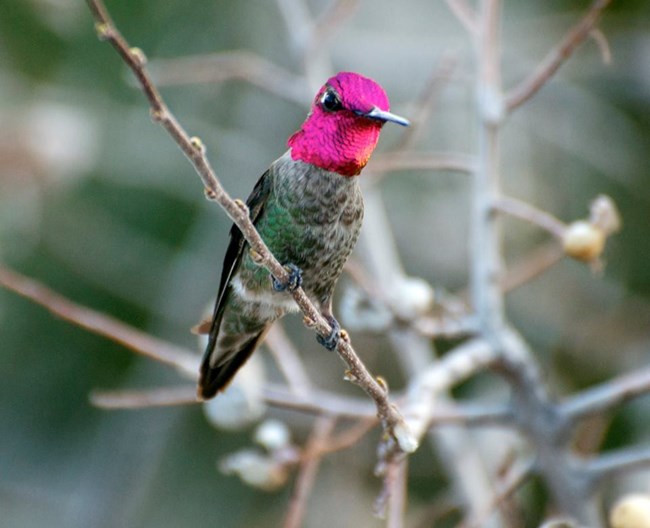
NPS Photo Anna’s Hummingbird (Calypte anna)This beautiful hummingbird is present year round in the northern regions of the Sonoran Desert. Adult males have a rose/reddish-orange iridescent helmet. They can easily be lured to backyard hummingbird feeders. 
NPS Photo Red-tailed Hawk (Buteo jamaicensis)The red-tailed hawk is one of the most common and widespread hawks in North America. It can be found year-round in the Sonoran Desert. Although they are named for the rusty-red tail feathers most adults have, their plumage colors are extremely variable. Some red-tailed hawks are rufous or almost completely black, while others can be mostly white.

NPS Photo Turkey Vulture (Cathartes aura)During the warmer months of the year, turkey vultures can often be spotted soaring over the Sonoran Desert. They search for food while soaring on thermals. If conditions are right, they can go for hours without flapping their wings. They locate food using their incredible sense of smell (which is unusual for birds) and by sight. Their featherless heads keep them clean, as they stick their entire head into the body cavities of dead animals to feast. 
NPS Photo White-winged Dove (Zenaida asiatica)During spring in the Sonoran Desert, the air is filled with the mating call of the white-winged dove. Their hoots and coos are so abundant that they sometimes drown out the sounds of other birds. 
NPS Photo Verdin (Auriparus flaviceps)The tiny verdin is not a close relative of any other bird in the Western Hemisphere. Instead, it is believed to belong to a group of small, inconspicuous birds from Eurasia and Africa. |
Last updated: May 5, 2025
